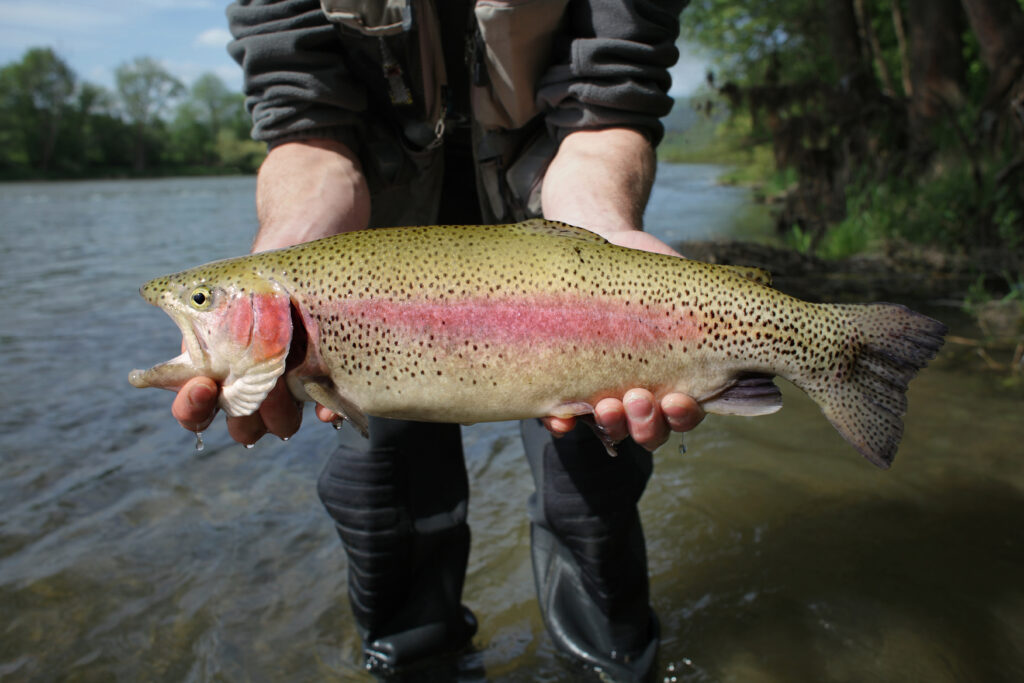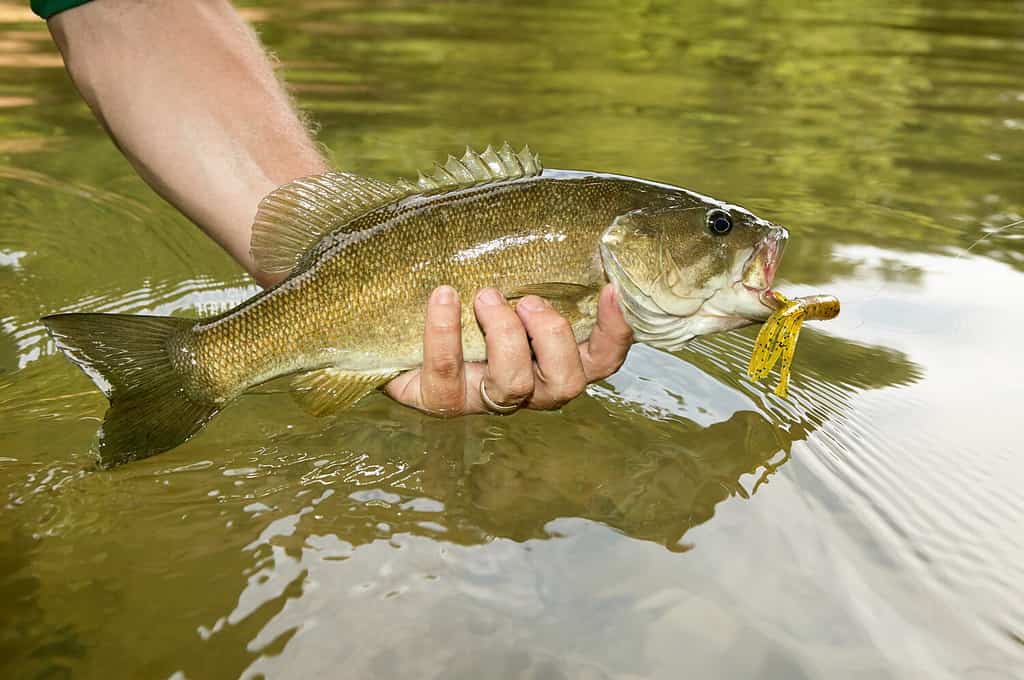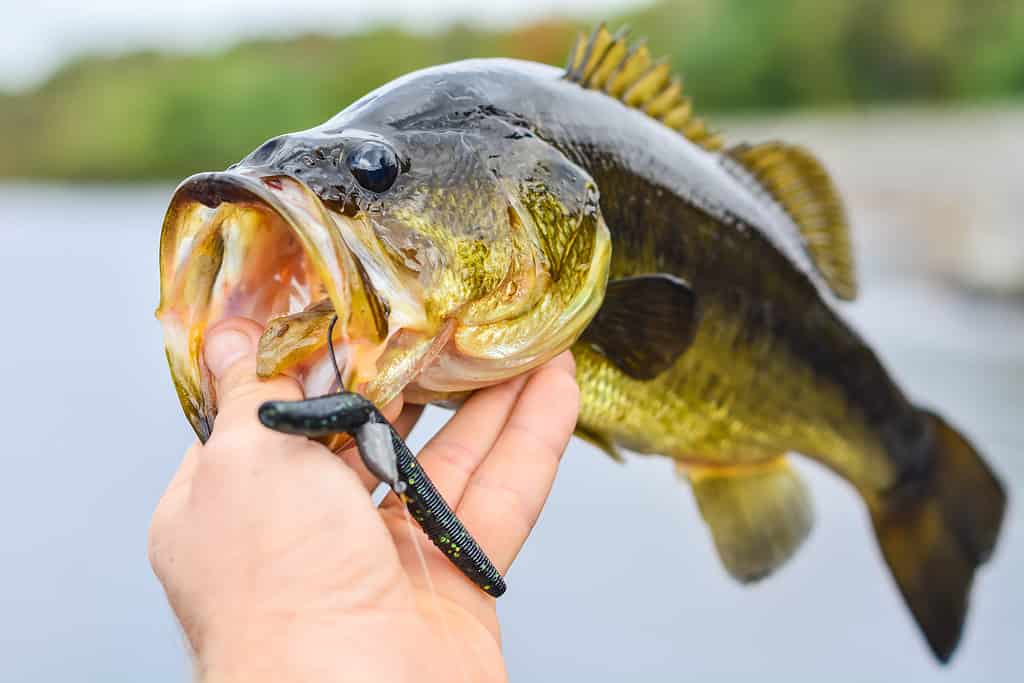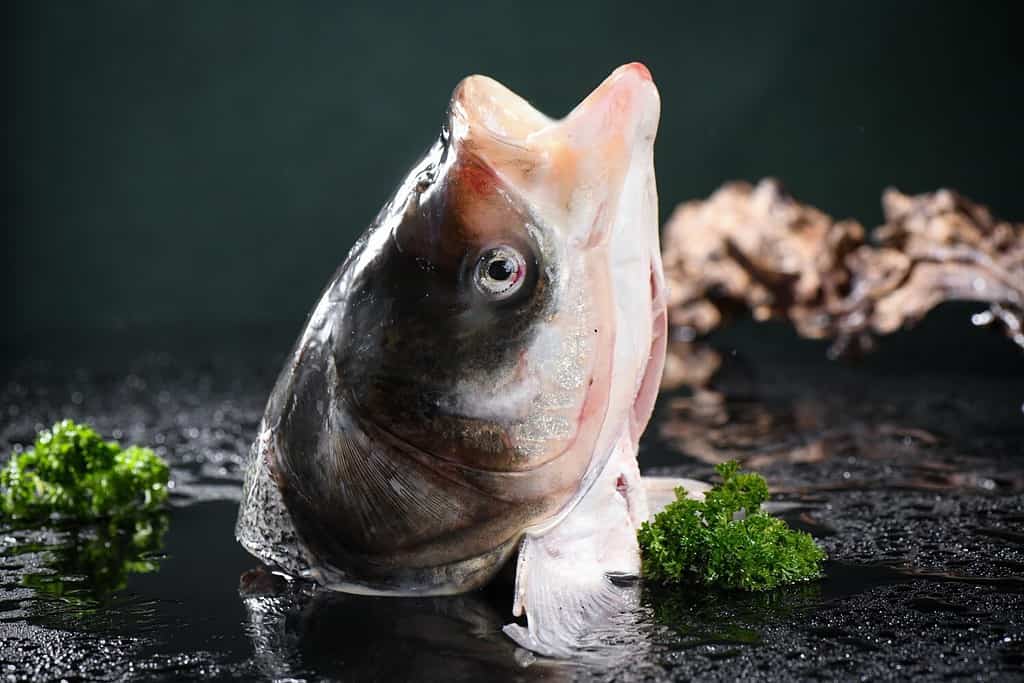Situated on the western coast of Southern California, Lake Arrowhead is a natural haven just a short 40-minute drive north of San Bernardino. This serene lake is embraced by a lush forested landscape, making it a peaceful retreat in the vicinity of nearby towns like Hesperia and Riverside. Of course, one of the main reasons to visit Lake Arrowhead is the chance to cast your line into its waters and see what kind of fish you can reel in. So, in this article, we will introduce you to the 9 types of fish you might encounter during your fishing adventure in Lake Arrowhead!
1. Rainbow Trout (Oncorhynchus mykiss)

Rainbow trout is the most popular fish in Lake Arrowhead.
©pictoplay/Shutterstock.com
The rainbow trout is a big fish shaped like a torpedo, usually weighing around 8 pounds and measuring between 20 and 30 inches when fully grown in the wild. It’s adorned with black speckles on its bluish-green upper body, has a shiny silver underside, and displays a pink line along its sides.
Compared to both diploid and triploid brown trout, rainbow trout are generally more active and aggressive but less daring. They also prefer to live in groups more than brown trout do, and they can tolerate warmer water conditions.
Their primary diet consists of insect larvae, bugs, and smaller fish. One efficient feeding strategy they use is to remain stationary in moving water with their mouths open, allowing insect larvae to simply flow in.
Each year, Lake Arrowhead restocks rainbow trout, making them the go-to catch for most anglers in the area. If you’re looking to fish here, trolling early in the morning with a 25-foot monofilament leader and a Rapala spoon in a fire tiger color yields the best results.
For those fishing from the shore, bait fishing tends to be quite effective. Common choices include natural or synthetic trout foods such as nightcrawlers and PowerBait.
2. Brown Trout (Salmo trutta)

Another common fish you’ll come across when fishing in Lake Arrowhead is the brown trout or German brown trout.
©iStock.com/KevinCass
In Lake Arrowhead, another fish you can expect to reel in is the brown trout, also known as the German brown trout. These fish typically have an olive to dark brownish-yellow color on their backs with yellow and dark spots. Their tail fin is not split and has a square shape with only a few or no dark spots.
Brown trout usually measure between 15 and 22 inches in length and can weigh anywhere from 1 to 5 pounds.
When it comes to their diet, brown trout are not picky eaters. They feed on a wide range of insects. When they’re still young and not quite big enough to catch small fish, juvenile brown trout mainly dine on tiny insects and insect larvae.
Unlike some fish that enjoy company, brown trout, especially the larger ones, prefer to go solo. They often claim a deep spot in the water as their own territory. In contrast, rainbow trout, another common fish in the lake, tend to gather and feed together in areas with a steady current. Brown trout are also more inclined to eat other fish, including other trout, making them skilled predators.
Sometimes, elusive populations of brown trout lurk in the deeper parts of Lake Arrowhead, giving boat anglers the opportunity to hook into a truly massive catch!
3. Kokanee Salmon (Oncorhynchus nerka)

Although rare, there is a possibility of catching a Kokanee salmon in Lake Arrowhead.
©Evan Benko/Shutterstock.com
One of the rarer fish you can come across in Lake Arrowhead is the Kokanee salmon.
These salmon have relatively small eyes and weak teeth. They are a shiny, silvery-blue color and have a body shape resembling that of a trout. During spawning, their bodies transition from dark to brilliant red, with an olive green head. Male Kokanee develop a hooked jaw called a kype, a hump behind their head, and more prominent teeth.
On average, Kokanee salmon measure around 9 to 15 inches. But in certain high-quality environments, they can grow up to a substantial 20 inches or more!
When it comes to their diet, Kokanee salmon are primarily fans of zooplankton, which are tiny aquatic creatures ranging from the size of a pinprick to that of a small fish hook. They’ll also consume small insects, freshwater shrimp, and plants whenever these food sources are available.
Kokanee salmon are known for their curious nature. They like to stay aware of their surroundings and can be quite assertive. When you’re angling for Kokanee, it’s not so much about them being hungry but more about their aggressive response to lures, which makes it an exciting endeavor.
While there have been reports of Kokanee salmon in the lake, catching one can be considered a stroke of luck since this species isn’t very common in these waters!
4. Smallmouth Bass (Micropterus dolomieu)

Smallmouth bass is more common in Lake Arrowhead than largemouth bass.
©CLP Media/Shutterstock.com
Both largemouth and smallmouth bass can be found in Lake Arrowhead, but unlike most Southern California lakes, it’s the smallmouth bass that dominates here.
These fish have an elongated body that’s usually pale brown or olive green, while their belly tends to be yellow-white. Look closely, and you’ll notice their body is adorned with numerous small, dusky brown blotches, and sometimes, there are five to 15 faint, dusky lateral bars. Adults are between 8 and 22 inches long.
Smallmouth bass are quite the predators, dining on lizards, crayfish, frogs, minnows, sculpins, threadfin smaller fish, shad, and insects. They’re carnivores and will eat any small creature they can fit in their mouth that’s found in their habitat.
After trout, Lake Arrowhead is renowned as a fantastic spot for catching smallmouth bass. These fish thrive in cooler and rockier environments compared to largemouth bass, making them a favorite among bass anglers.
When it comes to catching smallmouth bass, using typical bass lures in smaller sizes is a common approach. Additionally, jigs are often a go-to choice for smallmouth fishing.
However, since smallmouths in this lake, along with other predatory fish, frequently dine on silver shad, trolling a lure that mimics these baitfish is a strategic way to cover plenty of water and can yield excellent results.
5. Largemouth Bass (Micropterus salmoides)

Largemouth bass is a relatively common target in Lake Arrowhead.
©michal dziekonski/iStock / Getty Images Plus via Getty Images
While not as common as smallmouth bass, you can certainly find plenty of largemouth bass to target in Lake Arrowhead.
Largemouth bass sport a dark olive-green hue on their backs with lighter green sides that transition to a white belly. You’ll notice a dark, mottled band running along their sides. One distinguishing feature is that the upper part of their mouth extends beyond the eye. On average, these bass measure around 11 to 20 inches in length.
When it comes to their diet, juvenile largemouth bass primarily feast on water fleas, scuds, small baitfish, copepods, insects, and small shrimp. As they mature, their menu expands to include smaller fish like bluegill along with shad, snails, crawfish, frogs, snakes, and salamanders.
In terms of behavior, immature largemouth bass may gather in schools, but once they reach adulthood, they tend to be solitary. Although you might occasionally find several bass in a small area, they typically don’t interact with each other. Largemouth bass are skilled at lurking among plants, roots, or submerged limbs to ambush their prey.
If you’re angling for largemouth bass, consider that topwater fishing becomes highly effective, especially later in the summer when aquatic vegetation starts to flourish. Another effective technique involves making your lure mimic the fall of a mouse or another small creature landing in the water.
6. Crappie (Pomoxis)

Measuring up to 8 inches long, crappies are another type of fish that you can target in Lake Arrowhead.
©Steve Oehlenschlager/Shutterstock.com
During the springtime, it’s common to spot crappie along the extensive shoreline of Lake Arrowhead.
Crappie fish have oval-shaped bodies, silvery-green scales, downturned mouths, spiny fins, and distinctive gill covers. Identifying the two species in this genus is relatively straightforward. The black crappie can be recognized by irregular black spots on its body, while the white crappie features faint vertical stripes and has fewer spines on its dorsal (top) fin.
Typically, crappies measure around 4 to 8 inches in size.
Young crappie primarily feeds on tiny crustaceans known as zooplankton. As they grow, they start to eat small threadfin and gizzard shad, along with insect larvae, especially mayflies. They also enjoy dining on minnows, silversides, other crappie, and any other fish small enough to swallow.
Crappies have a curious nature, often inspecting objects closely. This behavior can definitely come in handy when you’re trying to catch them. If a crappie shows interest in something, it may either vaguely observe it from a distance (especially in clear water) or use its other senses to detect it, eventually moving in for a closer look. This behavior can be a valuable clue when you’re out crappie fishing in Lake Arrowhead.
7. Bluegill (Lepomis macrochirus)

Common near the shoreline of Lake Arrowhead, the bluegill measures up to 15 inches long.
©Brookieland/Shutterstock.com
Just like crappie, it’s quite common to come across bluegill near the shoreline of Lake Arrowhead during spring.
The bluegill has a flat, disk-like shape. Its main color is a shade of green, which shifts to orange or yellow on its underside. The cheeks have a hint of bluish-purple, giving it a unique look. You’ll also notice it has dark-colored flaps near its ears and subtle stripes running vertically along its body. The tail fin is not completely straight; instead, it has slightly rounded edges.
Typically, bluegill fish measure around 7 to 15 inches in length.
Bluegill has a diverse diet, including plant seeds, algae, zooplankton, insects and their larvae, small crustaceans, and amphibian eggs. Due to their specialized eyes adapted for detecting small moving objects in well-lit conditions, bluegill is most active from dawn to dusk.
Anglers typically use just an inch or two of worms since bluegills have relatively small mouths. Other live bait options include grasshoppers, crickets, catalpa worms, or any sufficiently sized insect that can be placed on a hook. Additionally, many artificial baits can be effective for attracting and catching bluegill in Lake Arrowhead.
8. Channel Catfish (Ictalurus punctatus)

One of the larger fish you can catch at Lake Arrowhead is the channel catfish.
©Alauddin Abbasi/Shutterstock.com
Another fish you can catch at Lake Arrowhead is the channel catfish.
The channel catfish has smooth skin, and its body color varies from shades of blue-gray to greenish-gray. The belly is a bright, silvery white, and the fins have an olive tint. When they’re younger, you’ll notice small, dark specks across their flanks, but these might fade as they age. It has four sets of thin, whisker-like feelers near its mouth. And you can easily identify the channel catfish by its uniquely deeply split tail fin.
Most grown-up channel catfish measure at least a foot long and average around 2 to 4 pounds.
These fish love to scrounge at the lake’s bottom, feeding on anything from insects and shellfish to tiny fish and even birds! Channel catfish are generally night owls, swimming around and looking for food once the sun sets. During daylight, you’ll mostly find them in the deeper parts of the lake, staying pretty inactive. They don’t really have a specific territory; they roam freely up and down the stream.
Fishing for channel catfish doesn’t require special techniques, but anglers prefer stillfishing and drift fishing. Most people have success by bottom-fishing using a range of bait like worms, pieces of other fish, or shrimp. Some even use specialized catfish baits.
9. Carp (Cyprinus carpio)

If you’re lucky, you might be able to fish for carp at Lake Arrowhead.
©xiaoxiao9119/Shutterstock.com
Wrapping up our list is the carp, a fish that’s easy to identify due to its small eyes and thick mouth. Its unique features also include a tail that splits into two and a single, jagged top fin. The scales are large and tough, and depending on its habitat, its skin can range from a greenish-brown to a silver or bronze shade, usually lighter on the belly.
These fish typically measure between one and two feet in length and weigh up to 10 pounds.
As for their diet, carp aren’t picky eaters. They primarily munch on plants but will also consume aquatic insects, small crustaceans, snails, and even fish eggs. To eat, they slurp up mud from the lake or river bed, spit it back out, and then feast on the floating particles.
Once the cold season is over and the water starts to warm up, you’ll find carp becoming more active. The warmer temperatures awaken their food sources and intensify their sense of smell, leading them to search for food.
When it comes to bait, carp are likely to go for dough balls, kernels of corn, or specially-made carp food. Interestingly, worms are not the go-to bait when it comes to fishing for carp.
Lastly, don’t underestimate the carp’s strength. They’re known for putting up a good fight, often outperforming other freshwater species. So, if you’re using lightweight gear, proceed with caution, as these strong fish can easily damage it.
Summary of Fishing in Lake Arrowhead: 9 Fish You Might Catch
| Number | Fish | Habitat |
|---|---|---|
| 1. | Rainbow Trout | Clear, deep water with access to inlet or outlet streams |
| 2. | Brown Trout | Behind rocks, trees, and different structures |
| 3. | Kokanee Salmon | Deep waters with temperatures around 50 degrees Fahrenheit |
| 4. | Smallmouth Bass | Along reefs, shallow rocky shoals, and drop-offs |
| 5. | Largemouth Bass | Shallow vegetated areas and deep, cool waters during summer |
| 6. | Crappie | Near brush piles and sunken tree |
| 7. | Bluegill | In water more than 10 feet deep or just above the thermocline |
| 8. | Channel Catfish | Along the curves, deepest holes, bends, and junction of channels |
| 9. | Carp | Windy and wavy parts of the lake and under overhanging trees |
The photo featured at the top of this post is © iStock.com/KevinCass
Thank you for reading! Have some feedback for us? Contact the AZ Animals editorial team.






